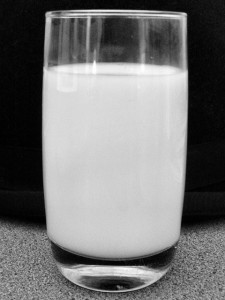 Lactose intolerance and dairy allergy are often used interchangeably. But in reality, they are actually very different entities.
Lactose intolerance and dairy allergy are often used interchangeably. But in reality, they are actually very different entities.
In this post, we will explain the differences between the two conditions, how to treat your symptoms and provide several dairy alternatives.
The difference between lactose intolerance and a dairy allergy:
Lactose intolerance is a result of the body not producing lactase, the enzyme required to digest lactose, the sugar in dairy.
An allergy to dairy products is an immune response to components in milk like proteins, fats and enzymes. The most common protein to cause a negative, allergic response in people is casein.
However, there are other theories as to what may cause lactose intolerance or an allergy to dairy.
According to Gut and Psychology Syndrome author Dr. Natasha Campbell-McBride, lactose intolerance may also be caused by not having the right bacteria in your gut. One of the major lactose-digesting bacteria in our guts is E.coli. If you are deficient in this bacterium, it will be harder for your body to digest lactose.
Another reason you may have difficulty digesting lactose has to do with enzymes called disaccharidases. These enzymes are responsible for breaking down double sugars, such as lactose, into monosugars in your gut. When these double sugars are not broken down properly, they cannot be absorbed into your body. Instead, they stay in your gut and become food for pathogenic bacteria, viruses, Candida and other fungi.
The bottom line is though, whether you have an allergy or intolerance, your body is still having a negative reaction and difficulty processing dairy. We hope reading our post will shed some light on your symptoms, equip you with ways to change your body’s response to dairy and provide you with ways to enjoy it.
Common symptoms of lactose intolerance:
Symptoms of lactose intolerance are usually felt between 30 minutes to 2 hours of ingesting milk or dairy.
- Stomach pain or cramping
- Gas and bloating
- Nausea
- Diarrhea
Common symptoms of dairy allergy:

Symptoms can be felt within minutes of ingesting milk or dairy, or they may be delayed several hours, even a few days.
Symptoms of a dairy allergy can be seen and felt in your digestive or respiratory system or on your skin.
- Vomiting
- Cramping
- Loose stools or diarrhea
- Hives or a rash
- Hay fever-like symptoms (runny nose, watery eyes, itchiness)
- Wheezing or difficulty breathing
- Sinus congestion and post-nasal drip
How to treat your lactose intolerance symptoms:
Lactose intolerance typically does not improve with age and, in fact, it may actually get worse. But there are a few options to relieve your symptoms.
- Talk with your health care practitioner or Advanced Allergy Solutions practitioner about enzymes that could help improve your body’s ability to digest lactose. We recommend Integrative Therapeutics’ Similase GFCF.
- Some hard cheeses and yogurt products are lower in lactose than milk. Try some of these products and see how your body reacts.
- We don’t recommend lactose-free dairy products, such as Lactaid, due to the processing and chemicals added to these products.
- Take probiotics to improve your gut bacteria. We recommend Prescript Assist.
How to treat your dairy allergy:
- Make an appointment at the clinic to be tested and treated for dairy.
- Test different types of dairy to see which ones you feel better with. For example, your body may respond better to certain products like kefir, yogurt, raw dairy, etc.
- Take a probiotic like Prescript Assist.
- Slowly introduce small amounts of high-quality, full-fat yogurt (preferably from grass-fed milk) into your diet to start exposing yourself to beneficial bacteria.
Alternatives to cow-based dairy products:
People who suffer from a dairy allergy or lactose intolerance sometimes find that they are more reactive to cow’s milk products, than those made with goat or sheep’s milk.
Why is this? Goat and sheep milk have smaller fat globules than cow’s milk, which makes it easier to digest. Goat’s milk is also the most similar in composition to human breast milk and has lower levels of lactose than cow’s milk, both of which make it easier to digest.
Lacto-fermented dairy, such as kefir, is also a safe and nutritious option. You can learn more about lacto-fermented foods here.
 You can find one of our favorite Kefir recipes (along with step-by-step instructions) here on The Kitchn.
You can find one of our favorite Kefir recipes (along with step-by-step instructions) here on The Kitchn.
Ghee is a clarified, unsalted butter and is naturally very low in lactose. Ghee is also great for cooking, as it is more stable and safe than other fats and oils. The Healthy Home Economist has an easy recipe for homemade ghee. (It’s expensive to buy at the store, but inexpensive to make!)
It is also important to mention: not all dairy alternatives are created equal.
Many conventional dairy milk alternatives, such as soy, almond, other nut milks and lactose-free milk are filled with chemicals, toxic additives, processed ingredients, sugar, GMOs and have very little nutritional value. Drinking these alternatives on a regular basis may have negative consequences on your health. Read the labels!
Benefits of grass-fed or raw milk:
According to Chris Kresser, there are many reasons why someone may prefer raw dairy to pasteurized dairy, ranging from nutritional to ethical to environmental.
In terms of nutrition, conventional milk comes from cows raised on an unnatural diet of soy, corn and other grains, antibiotics and hormones. Cows are meant to eat grass. Pasteurization will alter the live enzymes and nutrients that help to digest the milk proteins.
We recommend RealMilk.com to help you find a safe, local and trusted source for your raw dairy products.
Do you suffer from lactose intolerance or a dairy allergy? Have you tried any cow’s milk dairy alternatives, including raw dairy?
We’d love to hear from you!
